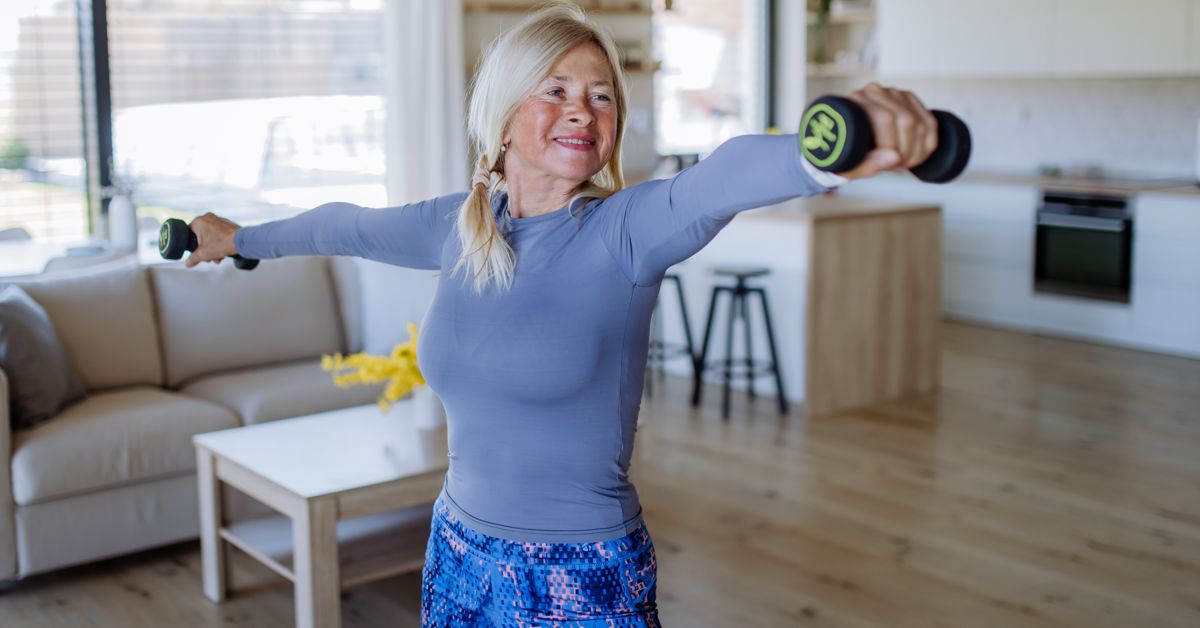A lateral raise is a strength training exercise that targets the muscles on the sides of the shoulders, known as the lateral deltoids.
These muscles are responsible for lifting the arms out to the sides, as well as rotating the arms inward and outward.
It is most commonly known for being a push excersice.
Strong lateral deltoids can help improve posture and stability in the shoulder joint, as well as contribute to a well-rounded upper body appearance.
How to do a lateral raise
To perform a lateral raise correctly, follow these 10 steps:
- Stand with your feet shoulder-width apart and your arms hanging naturally at your sides.
- Hold a pair of dumbbells or resistance bands in your hands, palms facing inward.
- Engage your core and keep your back straight.
- With a slight bend in your elbows, lift your arms straight out to the sides until they are level with your shoulders.
- Keep your elbows slightly bent throughout the entire movement.
- Avoid swinging the weights or using momentum to lift them.
- Pause shortly at the top of the movement before lowering the weights back down to the starting point in a controlled way.
- Exhale as you lift the weights and inhale as you lower them.
- Repeat for the desired number of repetitions.
- When you are finished, carefully lower the weights back down to the starting position.
Good form is crucial when performing a lateral raise.
It is extremely important to maintain good posture by keeping your back straight and engaging your core muscles to prevent excessive strain on your lower back.
By keeping good posture, you are ensuring that you are not putting unnecessary strain on your lower back, which can lead to serious health problems.
Choosing a weight that is appropriate for your fitness level is crucial for two reasons.
First, if the weight is too heavy, you may struggle to maintain good form and risk straining your shoulders.
Second, using a weight that is too light will not provide enough resistance to help you build muscle or see results.
What muscles work during a lateral raise?
The main muscles that work during a lateral raise are the lateral deltoids. However, the rotator cuff muscles and the supraspinatus also play a role in this movement.
The rotator cuff muscles help to stabilize the shoulder joint, while the supraspinatus helps to lift the arm.
The lateral raise not only engages the deltoids, but also the triceps and the back muscles.
These muscle groups work together to help support the weight being lifted during the lateral raise.
This makes the lateral raise an extremely effective exercise for building strength and muscular endurance in the upper body.
Benefits of the lateral raise
There are several benefits to incorporating lateral raises into your fitness routine.
In addition to targeting and strengthening the lateral deltoids, lateral raises can help improve shoulder stability and mobility.
Strong lateral deltoids can also help reduce the risk of shoulder injuries, such as rotator cuff strains or tears.
Lateral raises therefore play an important role in both injury prevention and overall shoulder health.
Lateral raises are a great way to contribute to overall upper body strength.
This, in turn, can help reduce the risk of injuries in other areas, such as the neck or lower back.
So not only are lateral raises great for your upper body, they can also be beneficial for your overall health!

How often should I do lateral raises?
Lateral raises are a great exercise to include in your strength training routine two to three times per week.
This will allow your muscles time to recover and adapt to the new stimulus, which is important for seeing results from your workout.
Muscles need time to recover in order to grow stronger, so it's important not to work the same muscle group more than a few times a week.
When starting out with lateral raises, it's important to use a light weight and focus on good form before gradually increasing the weight as you become more comfortable with the movement.
Lateral raises are a great way to work your shoulders, but it's important to start slowly and focus on using good form.
By gradually increasing the weight, you'll be able to get a great workout without having to worry about injuring yourself.
How should I progress the lateral raise?
One way to progress your lateral raise is to increase the weight you are lifting as your strength improves.
Another way to progress the lateral raise is to add more reps as you get stronger.
You can also try different variations of the lateral raise, such as using dumbbells instead of a barbell.
By mixing up your routine, you can continue to challenge your muscles and see results.
You can also try using different types of resistance, such as resistance bands or cables, to vary the challenge. This is a great way to keep your workouts interesting and to make sure that you are continually challenging your muscles.
Is there a bodyweight alternative to the lateral raise?
If you don't have access to weights or resistance bands, there are bodyweight alternatives to lateral raises that you can try.
One option is to perform lateral raises using no equipment at all, simply lifting your arms out to the sides with a slight bend in your elbows.
Another option for adding weight to the lateral raise exercise is to use household items as makeshift weights.
For example, you could fill two water bottles with sand or rocks and hold them while performing the lateral raise exercise.
This would provide extra resistance and help you to see results more quickly.
Conclusion
In conclusion, the lateral raise is a valuable exercise for targeting and strengthening the muscles on the sides of the shoulders.
By following the steps outlined above and maintaining good form, you can effectively perform lateral raises and reap the benefits of improved shoulder stability and upper body strength.

Leave A Comment